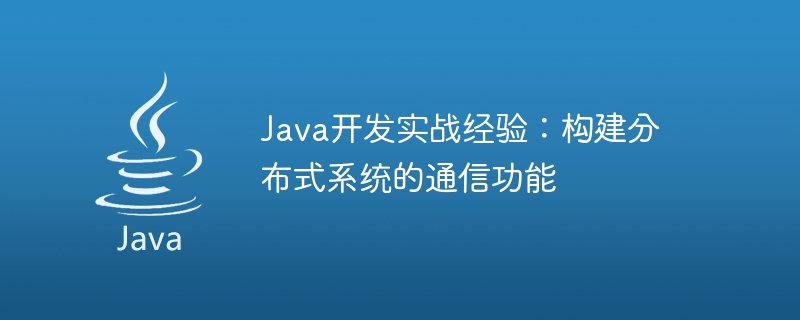Home >Java >javaTutorial >Practical experience in Java development: building communication functions of distributed systems
Practical experience in Java development: building communication functions of distributed systems
- WBOYWBOYWBOYWBOYWBOYWBOYWBOYWBOYWBOYWBOYWBOYWBOYWBOriginal
- 2023-11-20 12:03:431503browse

In today's era of highly developed Internet, distributed systems have become the preferred solution for many enterprises and organizations to build large-scale applications. As a Java developer, it is crucial to understand and master the communication functions of distributed systems. This article will introduce some practical experience in developing distributed systems, focusing on the techniques and methods of using Java to build communication functions.
First of all, it is very important to understand the concept of distributed systems. A distributed system is a collection of multiple computer nodes that work together through network communication. In a distributed system, communication is the basis for mutual communication between nodes, so it is crucial to implement an efficient and reliable communication mechanism. In Java, we can use various communication protocols and technologies to build the communication functions of distributed systems.
A common communication protocol is TCP/IP-based socket (Socket), which provides reliable byte stream transmission and connection-oriented communication. In Java, TCP/IP-based communication functions can be implemented using the Socket class provided by the java.net package. Through Socket, we can establish a two-way communication connection between the client and the server to realize the transmission and reception of data.
In addition to Socket communication based on TCP/IP, there are many other communication technologies that can be applied to distributed system development. For example, Remote Method Invocation (RMI) is a communication mechanism provided in the Java standard library, which allows programs to call methods of remote objects between different Java virtual machines. Using RMI, we can easily implement remote method calls in distributed systems, transfer parameters and obtain return values.
In addition, message queue is also one of the important technologies for building distributed system communication functions. Message queues allow senders to send messages to a queue, and receivers to receive and process these messages from the queue. Java provides multiple message queue implementations, such as ActiveMQ, RabbitMQ, and Kafka. By using these message queues, we can achieve efficient message delivery and decoupling, improving the scalability and reliability of the system.
In actual development, we also need to consider communication security issues in distributed systems. For example, data encryption and identity authentication, etc. For Java developers, the SSL/TLS protocol can be used to protect the security of data transmission. In Java, we can use related classes provided in the javax.net.ssl package to implement secure communication connections.
When building the communication function of a distributed system, the reliability and scalability of the system also need to be considered. For example, when a node in the system fails, other nodes need to be able to automatically perform fault tolerance and maintain the normal operation of the system. In order to achieve the fault tolerance of distributed systems, we can use message queue clustering and load balancing technology, as well as some distributed coordination services such as ZooKeeper.
Finally, for the communication function of distributed systems, it is also very important to carry out appropriate performance optimization. For example, through technologies such as batch processing and asynchronous processing, communication efficiency and throughput can be improved. In addition, using the compression and serialization technology of the network transmission protocol can also reduce the size of data transmission and the occupation of network bandwidth.
In short, building the communication function of distributed systems is one of the important skills that Java developers must master. In actual combat, we can use various communication protocols and technologies, such as TCP/IP-based Socket communication, remote method invocation, message queue, etc., to achieve efficient and reliable communication mechanisms. At the same time, considering communication security, fault tolerance and performance optimization are also key to building a distributed system. Through continuous learning and practice, we can continuously improve the level of communication technology in distributed system development and provide enterprises and organizations with more reliable and efficient application systems.
The above is the detailed content of Practical experience in Java development: building communication functions of distributed systems. For more information, please follow other related articles on the PHP Chinese website!

